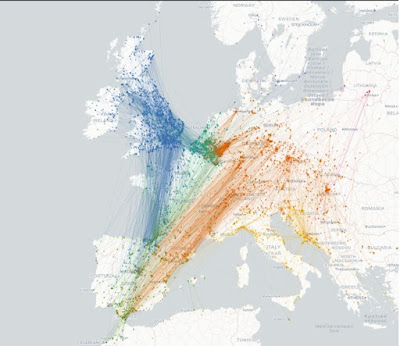News arrived of juvenile Goldfinch ALP8579 we caught and ringed at Oakenclough on 17 August 2022, when according to this blog :
‘Nothing much happened except for visible migration of more than 120 Swallows heading west in small groups together with several House Martins and a single Sand Martin. Invisible migration/new arrivals consisted of just 11 captures - 3 Blackcap, 2 Willow Warbler, 2 Meadow Pipit, 2 Goldfinch, 1 Goldcrest and 1 Chaffinch.’
Well something certainly happened later because one of those two Goldfinches was recaptured by French ringers on 7 January 2023 at Montmorillon, Vienne, some 143 days and 873 kms after our first capture.
Goldfinch migration - migrationatlas.org
From https://migrationatlas.org
“Ringing recoveries identify three main connections between breeding populations and wintering regions. Birds from the British Isles move to the continent in a S or SE direction, with most winter records from the Netherlands to Spain (a few in Morocco). Birds from West, Central and East Europe move to the SW, though population from northern Italy, the Balkans up to Poland and the Baltic states move either to South West or to South East Europe. Birds recovered in North Africa (mainly Morocco) originates from South West but also West Europe.”
Our UK Goldfinches are more migratory than many people realise, perhaps more noticeable when a garden that is usually full of Goldfinches becomes less crowded at the onset of cold weather. Our Goldfinch ALP8578 conformed to the migration behaviour and routes shown above. As a young bird born in the summer of 2022 it was just a matter of weeks before its inherited genes and DNA kicked in and sent it flying to the south of France many miles from its birth place.
Log in again soon bird lovers. I think we are catching Sand Martins later in the week if winds stay low and from the east.
Linking today to Eileen's Saturday.



Hello,
ReplyDeleteLove the Goldfinch closeup. The bird migration is just amazing.
I hope the weather cooperates for your Sand Martin catch.
Take care, enjoy your day and the week ahead.
Young Goldfinch. Tiny wings and body. 873 kilometers! Incredible.
ReplyDeleteAvian migration is so fascinating. At risk of repeating myself, thanks to you and all the citizen scientists around the planet for helping to monitor the birds of the world.
Fingers crossed for fair weather as there are Sand Martins waiting to be counted and fitted with jewelry!
All is good here! Too many life interruptions, not enough time afield. Sigh.
That is really interesting. I never think to look for rings on the bids here when I take photos, though I am sure if I took a photo of one with a ring I would register straight away.
ReplyDeleteYes busy here as well the garden is very demanding!!!!!
Keep well and good ringing. Cheers Diane
Interesting, tracking birds around the world has always interested me but I never got started and now that I have the time I haven't got the energy. Keep it going Phil for the likes of me. Take care
ReplyDeleteMike.
Seems quite extraordinary that one of only two Goldfinch ringed that day, would be caught by ringers in France less than five months later. What a good feeling you must have! Does that happen very often, where you hear that one of the birds you ringed was caught by a ringer elsewhere?
ReplyDeleteHello,
ReplyDeleteIt is interesting finding out where your ringed birds end up. Spending winter in the south of France sounds nice to me. Good luck with the Sand Martins.
Thank you for linking up and sharing your post. Take care, have a great weekend.
Wow, that's amazing and such a beautiful bird too ❤
ReplyDeleteFascinating news about the recapture of the Goldfinch in France after such a long time and distance. Such a pretty bird!
ReplyDeleteHello Phil :=)
ReplyDeleteIt has always amazed me how young juvenile birds know instinctively that they must migrate. The Goldfinch caught and ringed in France is a fine example. You really do a great job Phil, of monitoring their whereabouts. I love the photo of the hand held Goldfinch, it's a bird I never have the pleasure of seeing in Northern Portugal, although I have seen many in the South.
enjoy your weekend
All the best.
Very interesting post Phil, and always nice when one of your ringed birds turns up somewhere a bit further away. I must admit, I was not really aware that they moved so far. Migration is so fascinating.
ReplyDeleteThe migration really is amazing and so neat to learn about. Enjoy your week ahead!
ReplyDelete